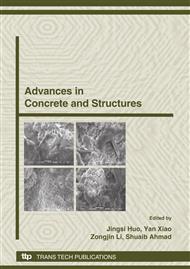[1]
Tang Yeqing. Advances in Adding-storey and Deviation Rectifying Technology in China. Building Structure. Vol. 21 (1993), pp.3-9. (In Chinese).
Google Scholar
[2]
Chen Jian, Song Jian and Lv ZhiTao. Experimental Study on the Storey-increasing Structure Using Frame-in-frame System. The Fourth National Symposium on the Appraisal and Strengthening of Buildings. 1998(11), p.920~927. (In Chinese).
Google Scholar
[3]
Wang Yan And Xu Yongchun. Experimental Study on the Seismic Behavior of Light Steel Adding-storey Model. Mechanics and Engineering. Vol. 21 (1995), pp.31-36. (In Chinese).
Google Scholar
[4]
Han Shengzhang, Qiu Kuining and Yang Jian-Jiang. Experimental Study on the Seismic Properties of Adding-storey Building. Building Science. Vol. 17 (2001), pp.29-33. (In Chinese).
Google Scholar
[5]
Lv Xilin And Zhangxin. Study and Application on a New Transfer Structure in Extension-story Engineering of Buildings. Industrial Construction. Vol. 36 (2006). pp.59-62. (In Chinese).
Google Scholar
[6]
Xie Junlong and Zhou Fulin. Test Investigation of Seismic Reduction Using Additional Stories As a TMD And its Application. World Information on Earthquake Engineering. Vol. 14(1998), pp.57-60. (In Chinese).
Google Scholar
[7]
Villaverde R. Roof Isolation System to Reduce the Seismic Response of Buildings:A Preliminary Assessment.Earthquake Spectra. Vol. 14(1998), pp.521-532.
DOI: 10.1193/1.1586013
Google Scholar
[8]
Tian Zhichang and Qian Jiaru. Roof Isolation System-A Vibration Absorber for Buildings. Tsinghua Science and Technology. Vol. 6(2001), pp.446-452.
Google Scholar
[9]
Lei Honggang and Qin Jiping. Research on the Feasibility of Adding-storey by Light-weight Steel. Journal of Taiyuan University of Technology. Vol. 32(2001), pp.331-334. (In Chinese).
Google Scholar
[10]
Wei Wenhui and Zhen Maowei. Application of Friction Damper in Seismic Retrofitting Buildings. Journal of Huazhong University Science and Technology. (Urban Science Edition). Vol. 21(2004), pp.21-25. (In Chinese).
Google Scholar
[11]
Zhang Zhongxian,Yang Shu and Wen Yinping. Coordination Vibration Reduction Structure of Infilled Frames Storey Adding Building. Noise and Vibration Control. Vol. 20(2000), pp.21-26. (In Chinese).
Google Scholar
[12]
Research on Shaking Table Test of Building with Added Storey and Using Friction and Energy Dissipation Devices. Journal of Building Structures. Vol. 22 (2001), pp.67-71. (In Chinese).
Google Scholar


